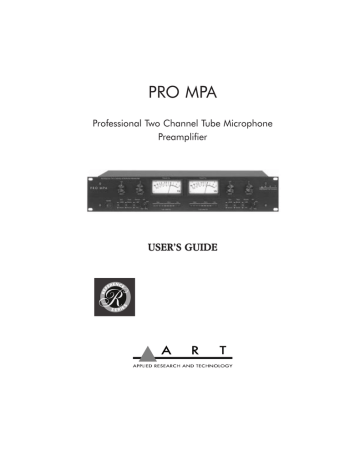power is present. However, if the mic doesnÕt need it, donÕt use it. Some things are best left untested!
HPF (High Pass Filter) Control
The HPF is a low frequency roll-off intended for use to Òtune outÓ unwanted rumbling or breath noises. A High Pass Filter allows frequencies above its set point to pass unaffected while gently rolling off frequencies below its set point. The range of the PRO MPAÕs HPF is 7Hz to 150Hz with a slope of 6dB per octave. This gentle slope allows unwanted low frequency information to be rolled off while not affecting the tonality of the input signal. In its fully counter-clockwise position, the filter has a set frequency of 7Hz which can be considered ÒbypassedÓ or off.
The filter is located after the Input Level Contol and before the tube circuitry.
Tube Character 10 Segment LED Array
Ten LEDs are provided on each channel which display how the tube gain is affecting the input signal. These LEDs are calibrated with the tube circuitry to give you an accurate visual of its output signal (**Note: these LEDs are pre-output level control).
Use this meter as a visual for setting the Input level to the PRO
MPA. The first four LEDs are labeled Clean. The tube is producing a clean output when this LED is lit.
The next four LEDs are labeled ÒwarmÓ. This is the optimal operating range for the PRO MPA. At this level, the tube is producing an output signal which most would term ÒwarmÓ.
Whatever you would like to call it is fine. YouÕll find the output signal has an enhanced bottom to low mid quality with smooth high frequency detail.
The last two LEDs are labeled ÒClipÓ. The first LED will light approximately 6dB before audible distortion occurs. If this light flickers, do not panic. The unique design of the PRO MPA allows the tube to distort well before any other gain stage.
When a tube goes into distortion it is a gradual process and tends to sound pleasing for a range before it turns into a distortion box. After some use youÕll find the Òsweet spotÓ of the PRO
MPA is with this light flashing fairly regularly. You may find a
ÒclippedÓ level is suitable for some applications.
**Note: Use the Tube Character Array to aid in setting the Input
Level Control.
VU Level Meter
Each channel of the PRO MPA has a backlit VU meter showing its output level. The Ò0Ó level is calibrated to +4dBu. Use the VU meter when adjusting the Output Level Control to aid in sending the proper level to your next piece of equipment.
REAR PANEL CONNECTIONS
ItÕs easy to interface the PRO MPA with other equipment.
Balanced XLR and unbalanced 1/4Ó phone, input and output connectors are located on the rear panel.
The PRO MPAÕs XLR connectors follow the AES standard of:
Pin 1 = Ground, Pin 2 = Hot (+), Pin 3 = Cold (-). The unbalanced 1/4Ó phone jacks are typical Tip - Hot (+), Sleeve -
Ground connections.
Input
Ideally, one input jack per channel should be used at a time.
However, because of its design, the PRO MPA can be hardwired into a rack without having to disconnect the XLR inputs when using the 1/4Ó jacks. If no load is placed on the XLR input
(no instrument or microphone connected) the 1/4Ó jack will function as if there was nothing connected to the XLR input. Both
PRO MPA inputs may be used simultaneously. However, the two signals will sum and the signal present at the XLR jack will tend to attenuate the signal of the 1/4Ó input.
Output
Both balanced and unbalanced output connections may be used simultaneously. This is particularly useful when using the
PRO MPA as a direct box for instruments or line level signals.
**Note: If you experience a grounding hum when using both output connectors (one to the console, one to an instrument amp) simultaneously, a ground loop may be the problem. To remedy this problem, disconnect the ground wire (pin 1) from the XLR cable plugged into the PRO MPAÕs output (or use a ground-lifted cable). This interrupts the ground path and therefore breaks the loop.
